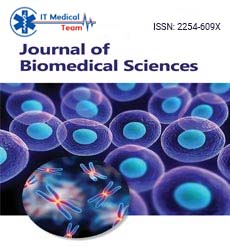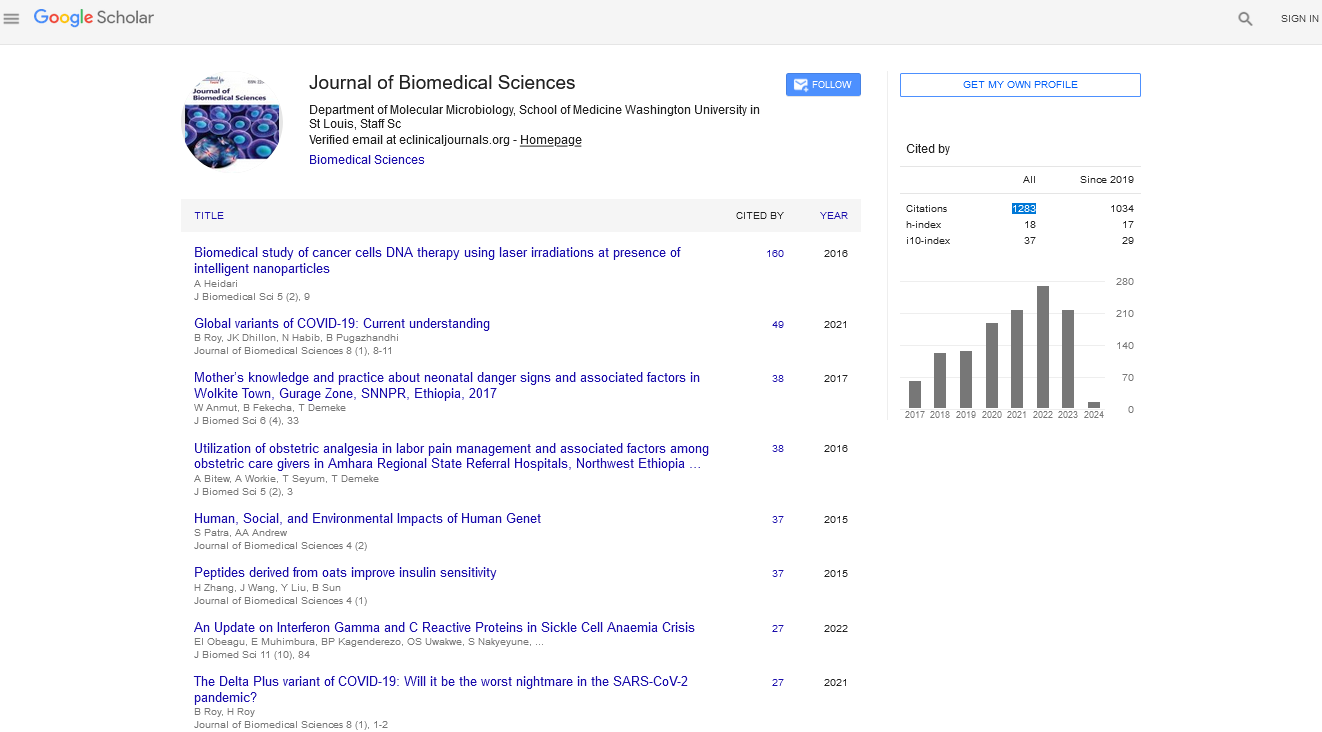Commentary - (2024) Volume 13, Issue 5
Neurobiology of Alzheimer's Disease and Emerging Therapies
Ricardo Mota*
Department of Neuroscience and Biomedical Sciences, University of Porto, Porto, Portugal
*Correspondence:
Ricardo Mota, Department of Neuroscience and Biomedical Sciences, University of Porto, Porto,
Portugal,
Email:
Received: 20-Sep-2024, Manuscript No. IPJBS-24-15329;
Editor assigned: 23-Sep-2024, Pre QC No. IPJBS-24-15329 (PQ);
Reviewed: 07-Oct-2024, QC No. IPJBS-24-15329;
Revised: 17-Oct-2024, Manuscript No. IPJBS-24-15329 (R);
Published:
24-Oct-2024
Description
Alzheimer’s Disease (AD) is a progressive neurodegenerative
disorder characterized by cognitive decline, memory loss, and
impaired daily functioning. It is the most common form of
dementia, affecting millions of individuals worldwide. The
neurobiology of Alzheimer’s disease is complex, involving a
combination of genetic, environmental, and lifestyle factors that
contribute to the disease’s development and progression.
Recent advances in understanding the underlying mechanisms
of AD have paved the way for emerging therapies aimed at
slowing its progression and improving patient outcomes. This
article explores the neurobiological aspects of Alzheimer’s
disease and highlights novel therapeutic approaches currently
under investigation.
Understanding the neurobiology of Alzheimer’s
disease
The neurobiology of Alzheimer’s disease is primarily
characterized by the accumulation of two hallmark pathological
features in the brain: Amyloid-Beta (Aβ) plaques and tau tangles.
These features contribute to synaptic dysfunction,
neuroinflammation, and ultimately neuronal cell death.
Amyloid-Beta plaques: Aβ plaques are formed by the
aggregation of misfolded amyloid-beta peptides, which are
cleaved from the Amyloid Precursor Protein (APP) by enzymes
known as secretases. In a healthy brain, Aβ is cleared efficiently;
however, in Alzheimer’s disease, the balance shifts, leading to
increased production and impaired clearance of Aβ. The
accumulation of these plaques is believed to trigger a cascade of
neurotoxic events, including synaptic dysfunction and
neuroinflammation, ultimately leading to cognitive decline.
Tau tangles: Neurofibrillary tangles are intracellular aggregates
of hyperphosphorylated tau protein. Tau is a microtubuleassociated
protein that stabilizes the structure of neurons. In AD,
abnormal phosphorylation of tau causes it to detach from
microtubules and aggregate into tangles, disrupting neuronal
transport and function. The presence of tau tangles correlates
more closely with cognitive impairment than amyloid plaques,
highlighting their significance in the disease’s progression.
Neuroinflammation: Neuroinflammation is another critical
component of Alzheimer’s disease pathology. Activated
microglia and astrocytes, the brain’s immune cells, release proinflammatory
cytokines and reactive oxygen species in response
to Aβ accumulation and neuronal injury. While this
inflammatory response aims to protect and repair the brain,
chronic neuroinflammation can exacerbate neuronal damage
and contribute to disease progression.
Genetic and environmental factors
The risk of developing Alzheimer’s disease is influenced by a
combination of genetic and environmental factors. Several genes
have been implicated in AD, with the most notable being the
Apolipoprotein E (APOE) gene, specifically the APOE ε4 allele.
Individuals carrying this allele have an increased risk of
developing Alzheimer’s, as it affects the metabolism and
clearance of amyloid-beta.
In addition to genetic predisposition, various environmental
factors contribute to the risk of Alzheimer’s disease. Lifestyle
choices, such as diet, physical activity, and social engagement,
play a significant role in brain health. Studies have shown that a
Mediterranean diet rich in antioxidants and healthy fats can
reduce the risk of cognitive decline. Furthermore, conditions
such as hypertension, diabetes, and obesity are associated with
an increased risk of AD, highlighting the importance of a healthy
lifestyle in mitigating disease risk.
Emerging therapies for Alzheimer’s disease
The increasing understanding of Alzheimer’s disease
neurobiology has led to the development of innovative
therapeutic strategies aimed at targeting its underlying
mechanisms. While no cure currently exists, several emerging
therapies hold promise for slowing disease progression and
improving cognitive function.
Amyloid-targeting therapies: One of the primary therapeutic
approaches involves targeting amyloid-beta pathology. Several
monoclonal antibodies, such as aducanumab (Aduhelm) and
lecanemab (Leqembi), have been developed to promote the
clearance of amyloid plaques from the brain. These antibodies
work by binding to aggregated forms of Aβ, facilitating their
removal by microglia. Clinical trials have shown that these
treatments can reduce amyloid plaque levels, but their impact on clinical outcomes remains under scrutiny. The FDA’s
accelerated approval of aducanumab has sparked considerable
debate regarding its efficacy and the need for further research.
Tau-targeting therapies: Given the critical role of tau in
Alzheimer’s pathology, therapies aimed at reducing tau
phosphorylation and aggregation are under investigation. Tautargeting
strategies include the development of small molecules
that inhibit tau phosphorylation, as well as immunotherapies
designed to promote the clearance of tau tangles. Preliminary
studies have shown promise, but more extensive clinical trials
are necessary to determine their efficacy in slowing disease
progression.
Alzheimer’s disease represents a significant challenge in
modern medicine, with its complex neurobiology influencing
disease development and progression. While no cure currently
exists, emerging therapies targeting amyloid-beta, tau
pathology, neuroinflammation, and neuroprotection hold
promise for improving patient outcomes. Additionally, lifestyle
modifications play a crucial role in managing disease risk and
progression. As research advances, a deeper understanding of
Alzheimer’s disease will pave the way for innovative treatments
and strategies to enhance cognitive health and quality of life for
individuals affected by this debilitating disorder.
Citation: Mota R (2024) Neurobiology of Alzheimer’s Disease and Emerging Therapies. J Biomed Sci Vol:13 No:5





